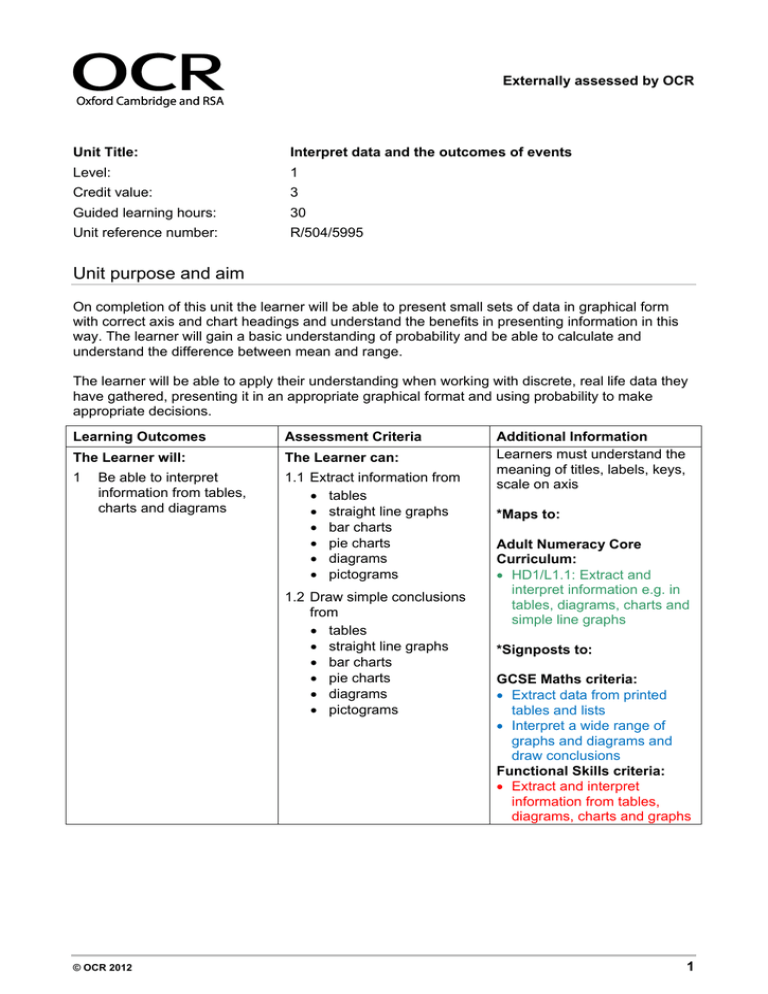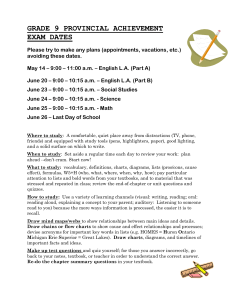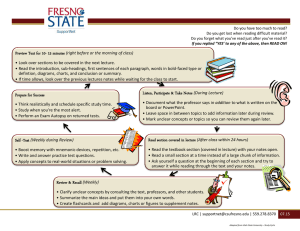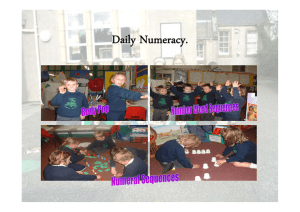Entry code 5757 - Interpret data and the outcomes of events
advertisement

Externally assessed by OCR Unit Title: Interpret data and the outcomes of events Level: 1 Credit value: 3 Guided learning hours: 30 Unit reference number: R/504/5995 Unit purpose and aim On completion of this unit the learner will be able to present small sets of data in graphical form with correct axis and chart headings and understand the benefits in presenting information in this way. The learner will gain a basic understanding of probability and be able to calculate and understand the difference between mean and range. The learner will be able to apply their understanding when working with discrete, real life data they have gathered, presenting it in an appropriate graphical format and using probability to make appropriate decisions. Learning Outcomes Assessment Criteria The Learner will: The Learner can: 1 1.1 Extract information from tables straight line graphs bar charts pie charts diagrams pictograms Be able to interpret information from tables, charts and diagrams 1.2 Draw simple conclusions from tables straight line graphs bar charts pie charts diagrams pictograms © OCR 2012 Additional Information Learners must understand the meaning of titles, labels, keys, scale on axis *Maps to: Adult Numeracy Core Curriculum: HD1/L1.1: Extract and interpret information e.g. in tables, diagrams, charts and simple line graphs *Signposts to: GCSE Maths criteria: Extract data from printed tables and lists Interpret a wide range of graphs and diagrams and draw conclusions Functional Skills criteria: Extract and interpret information from tables, diagrams, charts and graphs 1 Learning Outcomes Assessment Criteria 2 2.1 Identify appropriate methods of collecting data for a specific purpose from counting questionnaires Be able to collate and organise discrete data 2.2 Organise data from discrete data sets into: tally charts frequency tables 3 Be able to represent discrete data in tables, charts and diagrams 3.1 Identify appropriate labels for a chart or headings for a table 3.2 Select and mark appropriate scales on axes 3.3 Present data in: pictograms straight line graphs bar charts Additional Information *Maps to: Adult Numeracy Core Curriculum: HD1/L1.2:Collect, organise and represent discrete data e.g. in tables, charts, diagrams and line graphs *Signposts to: GCSE Maths criteria: Design data-collection sheets, distinguishing between different types of data. Functional Skills criteria: Collect and record discrete data and organise and represent information in different ways *Maps to: Adult Numeracy Core Curriculum: HD1/L1.2:Collect, organise and represent discrete data e.g. in tables, charts, diagrams and line graphs *Signposts to: GCSE Maths criteria: Design data-collection sheets, distinguishing between different types of data Produce charts and diagrams for various data types Functional Skills criteria: Collect and record discrete data and organise and represent information in different ways 4 Be able to calculate the mean 4.1 Calculate the mean of up to 10 data items 4.2 Identify the effect on the mean of outlying values 2 Interpretation is important *Maps to: Adult Numeracy Core Curriculum: HD1/L1.3: Find the arithmetical average (mean) for a set of data © OCR 2012 Learning Outcomes Assessment Criteria Additional Information *Signposts to: GCSE Maths criteria: Calculate median, mean, range, mode and modal class Compare distributions and make inferences Functional Skills criteria: Find mean and range 5 Be able to calculate the range 5.1 Calculate the range of up to 10 data items Recognise that the range measures the “spread” of the data Interpretation is important *Maps to: Adult Numeracy Core Curriculum: HD1/L1.4: Find the range for a set of data *Signposts to: GCSE Maths criteria: Calculate median, mean, range, mode and modal class Functional Skills criteria: Find mean and range 6 Be able to express probability using common vocabulary 6.1 Express probability: using the vocabulary “xxx in xxx chance” as Impossible as Certain as More likely or Less likely as Likely or Unlikely *Maps to: Adult Numeracy Core Curriculum: HD2/L1.1: Use the vocabulary of probability to discuss the likelihood of events *Signposts to: 7 Be able to express the probability of an event as a fraction or decimal or percentage © OCR 2012 7.1 Place events on the probability scale 7.2 List all possible outcomes of a single trial GCSE Maths criteria: understand and use the vocabulary of probability and the probability scale Functional Skills criteria: Use data to assess the likelihood of an outcome Recognise that o Impossible events have probability zero o Certain events have probability = one Interpretation is important 3 Learning Outcomes Assessment Criteria 7.3 Express probability as the number of ways the event can happen divided by the total number of possible outcomes Additional Information *Maps to: Adult Numeracy Core Curriculum: HD2/L1.2: Express the likelihood of an event using fractions, decimals and percentages with the probability scale of 0 to 1 *Signposts to: GCSE Maths criteria: Understand and use the vocabulary of probability and the probability scale Understand and use estimates or measures of probability from theoretical models, (including equally likely outcomes), or from relative frequency List all outcomes for single events, and for two successive events in a systematic way and derive related probabilities Functional Skills criteria: Use data to assess the likelihood of an outcome Assessment Externally assessed by OCR set and marked tests, requiring short-answer responses. Available as paper-based and on-screen assessment. A calculator can be used in this unit. *Mapping and Signposting Information This unit covers elements of the Adult Numeracy Core Curriculum (ANCC). For ease of reference we have indicated which parts of the unit map to elements of the ANCC. Achievement of this unit will also support learners who wish to progress to other programmes of learning and the Signposting information indicates areas within a Functional Skills (English/mathematics) or GSCE (English/mathematics) programme of learning that a learner will be able to more confidently progress towards after completion. This unit will not support progression towards any parts of the GCSE or Functional Skills criteria that are in italics. 4 © OCR 2012


